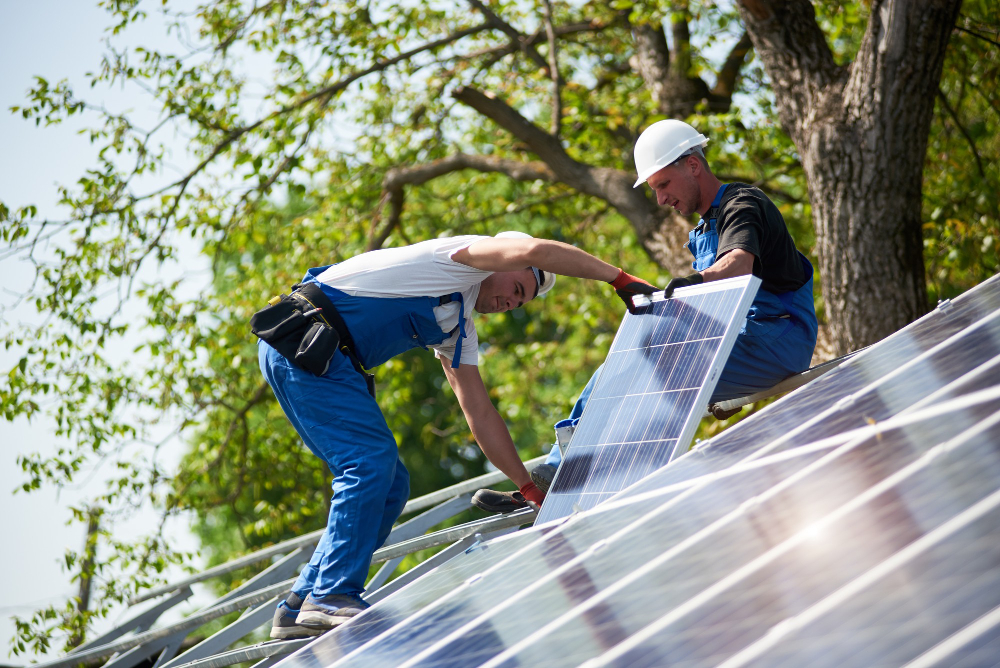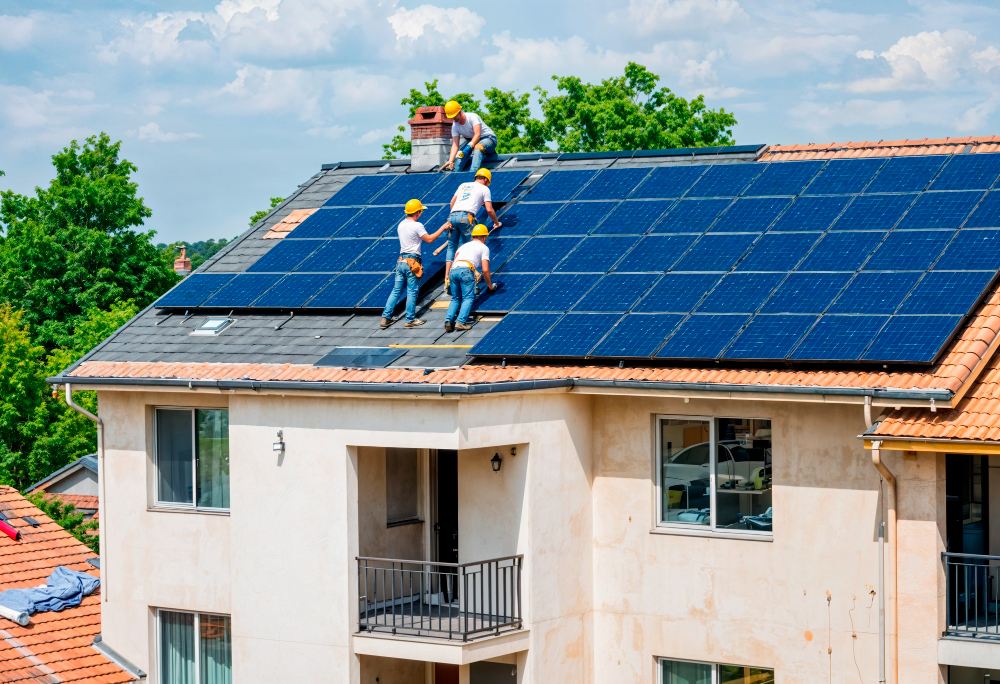In this fast-growing world where renewable energy has become a pressing topic, as a homeowner with a sleek, modern metal roof, you are eager to explore sustainable solutions to reduce your utility bills. Among these solutions, solar panels have emerged as a popular choice for many.
However, if you have a metal roof, you might wonder whether installing solar panels is feasible and how it compares to traditional roofing materials.
This article explores the compatibility of solar panels with metal roofs, highlighting the benefits and installation processes involved, to help you make an informed decision about integrating solar energy into your home.
Can Solar Panels be Installed on a Metal Roof?
When thinking about installing solar panels on metal roofs, a frequent question comes up: Is it possible to install solar panels on metal roofing? The answer is affirmative. Solar panels can certainly be installed on metal roofs. Metal roofs are an excellent option for solar panel installation due to their durability, corrosion resistance, and ease of mounting.
Types of Solar Panel Mounting Systems
Before we discuss more, let’s first look at the types of solar panel mounting systems available. Solar panels can be installed on various metal roofs, including aluminum, steel, and copper. There are two main types of solar panel mounting systems:
- Penetrating
- Non-Penetrating
Penetrating Systems
Penetrating systems require drilling into the roof to secure the solar panels. These systems create holes in the roofing material, which are essential for stable attachment. This method is typically utilized in new installations where roof integrity can be maintained.
Non-Penetrating Systems
Non-penetrating systems do not alter the roof structure; they use clamps or weights to hold the panels in place. This approach is advantageous for existing metal roofs, allowing homeowners to install solar energy solutions without modifying the roof. This method offers flexibility and minimises potential damage to the roof during installation.
By learning about these installation methods, homeowners can make wise choices for installing solar panels on metal roofs.
Process of Installing Solar Panels on Metal Roofs
Typically, a solar installer will drill holes in your roof to ensure secure mounting of the solar panels. This can be a significant concern for homeowners, as improperly mounted solar systems can lead to leaks or other roofing issues.
Most reputable solar installers offer expert craftsmanship and roof warranties to assure customers that the installation will not cause problems. However, if you have a metal roof, new holes are likely unnecessary, which reduces the risk of future issues.
Several alternative mounting solutions simplify solar installation on metal roofs.
Here’s a process for setting up solar panels on a metal roof surface:
Roof Assessment & Permit Approval
Start by assessing your roof to ensure it can bear the extra weight of the panels. This may require engaging a professional to ensure your roof structure meets local codes and regulations.
Select Mounting Hardware
Depending on your roof type, choose the appropriate mounting hardware. For standing seam roofs, use clamp mounts; for corrugated roofs, opt for brackets with watertight seals.
Install Mounting System and Panels
Once the hardware is mounted, install the panels to maximize sunlight exposure. Adjusting the angle and accurate positioning is crucial for optimizing solar panel performance.
Connect the Electrical System
Finally, an electrician will connect the panels to your home’s electric grid, enabling you to generate electricity. This includes wiring the panels, installing inverters, and connecting to the grid if needed.

Types of Metal Roofing for Solar Panels
Standing Seam Metal Roof
Standing seam metal roofs are one of the simplest options for solar installations. Special clamps attached to the seams mean there’s no need to drill, preserving the roof’s integrity and ensuring a watertight seal.
Some solar panel mounting manufacturers have specifically designed products for standing seam metal roofs. If this is your roof type, your installer can use a system that clamps onto the seams without creating any holes.
This approach also speeds up installation times and can lower labor costs since the installer doesn’t have to drill.
Metal Tile Roof
The mounting process for metal tile roofs resembles that of traditional tiled roofs. Special hooks and brackets secure the solar panels without damaging the roof. Manufacturers also provide tile replacement mounts to facilitate the installation of solar panels on metal tile roofs.
These products mimic the shape of roof tiles and can replace existing tiles during installation. This simplifies the installation process and ensures that your solar setup is completely waterproof, as the installer will replace tiles on your roof to mount the panels.
Corrugated Metal Roof
Corrugated roofs necessitate a distinct mounting approach because of their wavy design structure. Mounting brackets are fastened with bolts, and careful sealing is employed to prevent water leaks.
Advanced flashing techniques are used to maintain the roof’s weatherproofing properties. Unlike the previous two metal roofs, corrugated roofs usually require drilled holes for installation.
Mounting companies offer specialized solutions for installing solar panels on these roofs, including straddle blocks that sit on the ridges and allow screws to secure the system to the roof. Waterproofing is especially crucial with these mounting systems, given that your roof will have holes for attaching the racking system.
Reasons for Choosing the Best Metal Roofing for Solar Panels
Metal roofs are great for solar panels because they last long and are strong. They act as a solid foundation for solar panel installation, last longer than conventional materials, and can lower energy expenses thanks to their reflective qualities.
Here are the reasons why metal roofing is an excellent choice for solar panel installations:
Durability and Longevity
Long Lifespan: Metal roofs boast an impressive 40 to 75 years or more lifespan, which perfectly aligns with the 25 to 30-year life of solar panels, making them a solid long-term investment.
Structural Strength: Metal is a sturdy material that can support the extra weight of solar panels without affecting the roof’s structure.
Maintenance: Metal roofs need very little maintenance, making them an excellent option for solar panels, which are similarly low in upkeep.
Energy Efficiency and Savings
Reflectivity: Metal roofs in lighter shades effectively bounce back sunlight, lowering cooling costs and improving energy efficiency.
Reduced Cooling Costs: The reflective quality of metal roofs can significantly decrease energy bills by lowering air conditioning needs.
Installation and Aesthetics
Easy Installation: Numerous solar panel mounting systems are compatible with metal roofs, enabling straightforward installation without roof penetration and maintaining roof’s structural integrity.
Aesthetic Appeal: Available in various colors and styles, metal roofs can create an attractive rooftop that beautifully matches the contemporary design of solar panels.
Standing Seam Advantages: Standing seam metal roofs are particularly advantageous for solar panel installations since they offer mounting systems that securely clamp onto the seams without drilling holes.
Conclusion
Solar panels can be set up on metal roofs, making them a good choice for homeowners who want to harness solar energy. Installing solar panel systems on metal roofs is practical and beneficial because these roofs are strong and can support the weight of solar panels.
At Rockford Coastal Homes, we provide roofing services and solar installation services across Georgia including Richmond Hill, Bloomingdale, Pooler, Rincon, and Savannah. Need any help? Feel free to contact us.


